If you’re a fan of Japanese food, chances are you’ve encountered somen and soba noodles at some point.
They look similar but have distinct differences – but what those differences exactly?
In this blog post, we will explore the wonders behind these two types of noodles, taking in their ingredients and history to explain somen vs soba.
Learn both their similarities and distinctions so that next time you see them on the menu or at your local Asian market, you can know exactly which type it is with complete confidence.

What are Somen and Soba?
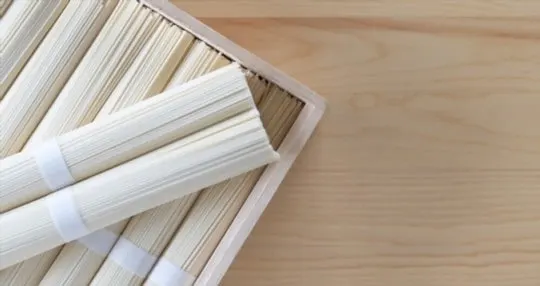
Somen and soba are two types of Japanese noodles that are often used interchangeably in various dishes.
Somen noodles are thin, white, and made from wheat flour, while soba noodles are thicker, grey or brown, and are made from buckwheat flour mixed with wheat flour.
Both noodles have a long history and a unique taste that is different from each other.
Somen noodles are usually served cold during summer months in Japan.
They can be enjoyed with dipping sauces like tsuyu or soy sauce-based sauce.
Traditional toppings for somen include sliced green onion, grated ginger, shiso leaves, wasabi paste, or tempura bits.
On the other hand, soba is eaten all year round in Japan.
It can be served hot or cold with various toppings such as shredded nori seaweed, scallions, wasabi paste, grated daikon radish root on top of the noodle soup.
The nutty flavor of soba makes it perfect for pairing with certain foods like mushrooms, tofu or shrimp tempura.
Differences Between Somen and Soba
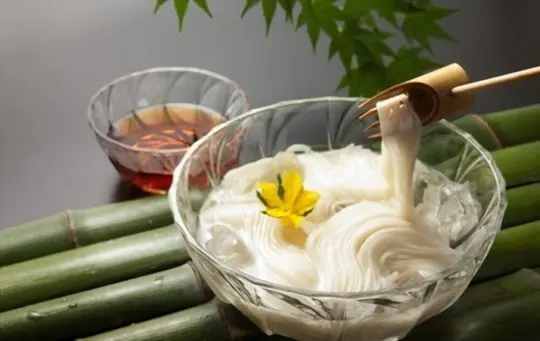
When it comes to Japanese noodles, somen and soba are two of the most popular choices.
While they may look similar in appearance, there are several key differences between the two.
Understanding these differences can help you choose which noodle dish to order depending on your taste preferences and dietary needs.
Ingredients Used
Somen and soba are two types of Japanese noodles that are commonly consumed.
The ingredients used to make these two dishes are quite different, resulting in differences in texture, flavor, and nutritional value.
Here is a breakdown of the key ingredients used in somen and soba:
To create somen noodles, wheat flour, salt, and water are used.
Some variations of somen may also include potato starch or cornstarch.
Soba noodles, on the other hand, are made with buckwheat flour mixed with wheat flour and water.
When it comes to cooking the noodles themselves, both require boiling in water until they reach the desired level of doneness.
In terms of nutrition, there are some variations between the two dishes as well.
Buckwheat is considered a healthier alternative to wheat flour as it contains more fiber and essential minerals such as magnesium and zinc.
However, soba noodles often contain higher levels of sodium than somen due to the addition of soy sauce or other seasonings.
The ingredients used in making somen and soba noodles significantly affect their flavor profiles.
While wheat flour is the primary ingredient for making somen, buckwheat flour dominates the composition of soba noodles alongside wheat flour which results in richer nutritional content for this dish.
Both dishes can be complemented by various sauces such as soy sauce which affects their flavor uniqueness differently depending on what has been added to them besides basic seasoning like salt.
When it comes to nutrition, soba noodles have an edge over somen since they contain more nutrients such as zinc, magnesium, and fiber relative to their counterpart.
With different key ingredients used in making each type of noodle, somen and soba have their own specific tastes that make them stand out among the numerous types of Japanese noodles that exist.
Texture and Color Comparison
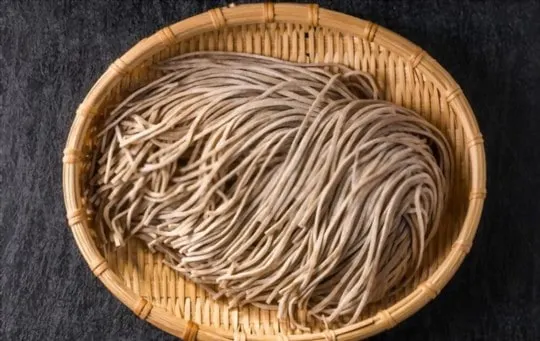
Texture and color comparison is an important aspect when it comes to differentiating between two dishes.
In the case of somen and soba, while they may appear similar at first glance, there are subtle differences that set them apart.
While both types of noodles are delicious in their own right, each one has its own unique texture and flavor profile that sets it apart from the other.
The decision ultimately comes down to personal preference and what type of dish you’re looking to create.
Nutritional Value
Somen and soba are both popular Japanese noodles that are enjoyed both hot and cold.
In addition to their unique flavor profiles, they also differ in terms of their nutritional value.
It is clear that while somen noodles contain more carbohydrates, soba noodles are higher in protein and fiber content.
Protein is essential for building and repairing tissues in the body as well as maintaining healthy bones, muscles, skin, and blood vessels.
On the other hand, a high intake of carbohydrates can lead to spikes in blood sugar levels which can be detrimental to one’s health over time.
Fiber is important for overall gut health and can help prevent constipation, reduce inflammation, and even lower the risk of certain cancers.
Flavor and Taste Differences
A significant difference between somen and soba noodles is their flavor and taste.
Somen noodles are known for their light and smooth texture, making them ideal for dishes that require a delicate flavor.
On the other hand, soba noodles have a robust and nutty taste, which can add depth to any dish.
Somen noodles have a refreshing taste that makes them perfect for dishes such as salad, cold soups, or hot pot.
Alternatively; soba noodles stand out because of its stronger, heavily textured endowment.
They’re an exceptional option for tempura dipping sauce or warm stir-fry recipes.
In summary: if you prefer delicate flavors in your food, go for somen noodles.
But if you enjoy bolder flavors with more texture, then soba noodles are the way to go.
Cooking and Serving Differences
When it comes to cooking and serving, there are some notable differences between somen and soba noodles that are worth considering.
As you can see, somen noodles cook much quicker than soba noodles.
This makes them a great option for times when you need to get dinner on the table fast.
Additionally, because they are so thin and delicate, they are considered a more delicate type of noodle compared to the heartier soba.
The type of broth used with these noodles also differs significantly.
Soba noodles tend to be served in a richer broth that can have a more complex flavor profile, while somen noodles traditionally come with a lighter broth that allows their delicate flavor to shine through.
Finally, the serving style for these two types of noodle dishes is quite different as well.
Somen noodles are typically served cold with dipping sauce or soup on the side, while soba is often served hot in soups or stir-fries.
How to Serve Somen and Soba?
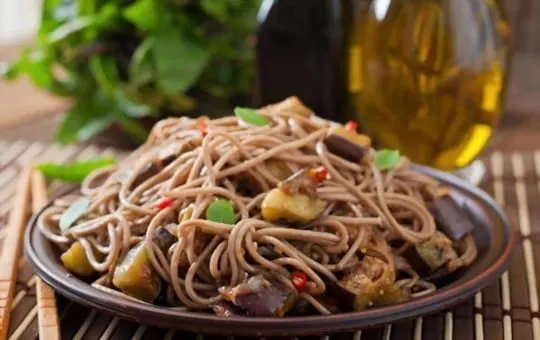
Serving somen and soba is quite easy, as they are typically served similarly.
Both noodles can be consumed hot or cold and are usually placed in a bowl with soup or sauce poured over them.
The main difference between them is the type of soup or sauce used.
To serve somen or soba without making a mess, it is best to use chopsticks instead of a fork.
Start by picking up a small amount of noodles with your chopsticks; you can then dip them into your preferred soup or sauce before eating them.
Drinking the leftover soup after finishing the noodles is also customary.
When serving cold somen or soba noodles, make sure to rinse them in cold water first to remove excess starch and prevent the noodles from clumping together.
Once rinsed, place the noodles on ice cubes until serving time.
It’s essential to note that both somen and soba soak up liquid very quickly.
As such, it’s best to serve the noodles immediately after preparing them for optimal flavor and texture.
Popular Brands of Somen and Soba
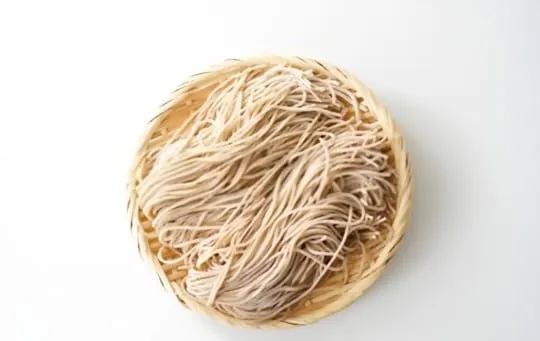
When it comes to Japanese noodles, there are various brands available in different parts of the world.
Some popular brands offer both somen and soba noodles in their product lines.
These are just a few examples of popular noodle brands.
However, there are many other great options out there for those who love somen or soba.
It’s essential to try different brands to find the one that suits your tastes.
Overall, when shopping for somen or soba noodles, make sure to read the package carefully.
Check for the type of noodle (fresh or dried), whether they’re organic or not, gluten-free status, etc.
Conclusion
Somen and soba are different not just in their ingredients but also in their thickness, texture, and usage.
While somen is very thin and has a delicate, silky texture that’s perfect for serving cold with dipping sauces during the summer months.
On the other hand, soba is thicker than somen and has a chewy texture that can be served either hot or cold depending on your preference.
When it comes to usage, soba is typically used as a topping for salads or in noodle soups while somen noodles are often served in soups or chilled with dipping sauces.
It’s interesting to note that both these noodles have been popular in Japanese cuisine for centuries now.

Somen vs Soba: What’s the Difference?
Ingredients
- Somen
- Soba
Instructions
- Choose between two items based on your preference and availability.
- Follow the cooking directions for your chosen option, using the appropriate ratio of ingredients.
- Prepare it according to your desired recipes.
- Incorporate them into your dish, adjusting the amount to suit your taste.
- Enjoy the unique taste experience and experiment with different dishes to explore their versatility.

Andrew Gray is a seasoned food writer and blogger with a wealth of experience in the restaurant and catering industries. With a passion for all things delicious, Andrew has honed his culinary expertise through his work as a personal chef and caterer.
His love for food led him to venture into food writing, where he has contributed to various online publications, sharing his knowledge and insights on the culinary world. As the proud owner of AmericasRestaurant.com, Andrew covers a wide range of topics, including recipes, restaurant reviews, product recommendations, and culinary tips.
Through his website, he aims to inspire and educate fellow food enthusiasts, offering a comprehensive resource for all things food-related.

Leave a comment